The broad scope of UC research
The California Master Plan for Higher Education designates the University of California as the primary state-supported academic agency for research. UC research contributes to the state and to the nation through discoveries that improve health, technology and the quality of life.
UC has more than 800 research centers, institutes, laboratories and programs that span ten campuses, five medical centers, three national energy laboratories and numerous research facilities. All forms of intellectual inquiry are represented, from the search for sub-atomic particles to the study of distant galaxies, and all things in between, including our own species, the natural world we inhabit and the societies we create. The extraordinary diversity and quality of research at UC is reflected in the rankings assigned to UC campuses (see Chapter 14).
Evaluating the research enterprise
UC’s research may be assessed in a variety of ways: expenditures; quality and impact; enhancement of UC students’ experience; contribution of findings to public knowledge; and economic and societal benefits. This chapter focuses on quantitative measures such as expenditures, employees and publications.
However, these measures do not present a comprehensive account of UC’s research. They underrepresent research achievements in the arts, humanities, social sciences and theoretical sciences, where work leaves less of a financial footprint, but still contributes to UC education and society.
Sources of Research Funding
Research expenditures at UC nearly doubled over the last 15 years, to about $4.3 billion. In comparison with its peers, UC excels in research dollars per faculty member. Federal funds account for more than half of the total. Private support is a growing component, funding research in health, life sciences, technology, materials engineering, education and other fields. Private support only accounts for about 22 percent of research awards — 10 percent from corporations and 12 percent from nonprofit organizations. This leaves UC’s research susceptible to federal budgetary fluctuations.
A small sample of research funded in 2014–15:
- UC Berkeley was awarded $15 million by the William and Flora Hewlett Foundation to study cybersecurity and internet policy.
- UC Davis School of Veterinary Medicine received $47.6 million from the US Agency for International Development to monitor the global emergence of pathogens from animals.
- UC Irvine’s Center for Chemistry at the Space-Time Limit was granted $8 million from the National Science Foundation.
- UCLA received $5.2 million from Biomarin Pharmaceuticals to explore gene therapy for sickle cell disease.
- UC Merced was granted $2.7 million by the National Institutes of Health for research on copper exposure and neurological disorders, including Alzheimer’s.
- UC Riverside was awarded $3 million by the U.S. Department of Energy to study nanoscale electronic systems.
- UC San Diego received $21.5 million from the National Science Foundation to study the role of high-performance cyberinfrastructure in furthering science.
- UC San Francisco was awarded $11.2 million by the National Institute of Allergy and Infectious Diseases to improve the delivery of AIDS therapy in Africa.
- UC Santa Barbara’s Kavli Institute for Theoretical Physics received $4.6 million from the National Science Foundation.
- UC Santa Cruz was granted $3.5 million by the National Human Genome Research Institute for its Genome Browser.
- UC’s Division of Agriculture and Natural Resources was awarded $2 million by the US Geological Survey for drought research.
Research activities
Nearly two-thirds of direct research expenditures in 2014–15 went to salaries and benefits. Only about 25 percent went to faculty; the majority supported staff researchers, and about one-fifth went to students and postdocs.
Research results — enhancing instruction
UC’s research enhances the student experience. Faculty often incorporate their research results into their courses. This provides UC students with access to insights and discoveries even before they are published. UC students also participate; the 2014 UC Undergraduate Experience Survey found about half of seniors had been involved in research projects or creative activities.
Participation in research defines graduate education, and graduate student researchers make up a significant portion of the research workforce. In 2014–15, of UC’s 52,500 graduate students, about 15,800 were employed as paid research assistants. UC also trains about 6,200 postdoctoral scholars.
Research results — spurring the economy
The economic benefit of UC’s research enterprise to the state of California is significant. For every dollar spent by UC, the state’s economy increases by about two dollars. The $4.3 billion spent by UC on research multiplies to nearly $9 billion statewide. Research employees’ salaries are spent all across the state. Research funds also purchased over $1 billion in goods and services, with one in three dollars supporting California vendors.
In addition to direct economic impact, many businesses in California are based on technology developed at UC or rely on the skills of UC graduates. Research becomes public knowledge through publications and the patent process. These innovations enhance industries, stimulate economies, and improve health and well-being. Over the past two decades, UC has secured more licensable patents than any other U.S. research university. Since 1976, 934 startup companies have been founded around UC inventions, with 85 percent based in California.
Research results — diffusing knowledge
Publications are perhaps the most visible results of UC research. This chapter includes an analysis by academic publisher Elsevier of the impact of UC research publications, attributing one out of 12 research publications in the United States to UC.
The books, periodicals and journals in which research findings are published are expensive and often only available through subscriptions. This puts them beyond the reach of many researchers, students, journalists and others with limited financial resources, especially in developing regions. To ensure that research findings become public, UC has adopted Open Access policies enabling UC authors to make their articles available through the eScholarship repository, operated by UC’s California Digital Library. This chapter presents a progress report on UC’s Open Access program since its inception in 2012, charting publication availability and worldwide utilization.
Research results — improving global health
During 2014–15, about 2,900 clinical trial research projects were underway at UC. Clinical trials occupy a unique position in academic research. Unlike basic research, these projects represent the final stage in the journey from a scientific discovery to an effective treatment. Of the research dollars that came to UC from businesses during 2014–15, half of the total was directed toward clinical trials.
Research results — addressing climate change
UC is a leader in research on technologies and practices to reduce carbon emissions and impacts. In addition to appropriations from the U.S. Department of Energy to Lawrence Berkeley National Laboratory, UC campuses secured about $491 million over a six-year period for work on carbon neutrality.
Research workforce changes
UC’s research mission faces numerous challenges. These include recruiting and retaining faculty, attracting and supporting graduate students and postdoctoral researchers, and fully funding the research enterprise, because UC does not recover the full costs of research from either governmental or private sponsors.
A nationwide issue is the lack of federal support for basic research and development. For more than a decade, federal research support has been essentially flat, with the exception of American Recovery and Reinvestment Act stimulus funds. Between late 2009 and 2011, the Act provided UC with over $1 billion for research. In 2012–13, cutbacks in federal spending reduced UC’s research awards to early 2000’s levels. As a result, the workforce has fallen by 9.2% from its peak in 2011 of nearly 29,600 FTE (full-time equivalent) to 26,890.
The effect of these reductions has impacted the University’s instructional mission, as research funding supports graduate student researchers and postdoctoral researchers. The impact has varied by campus and by discipline, with more of an impact on fields such as medical research, which depend on funding from UC’s largest research sponsor, the National Institutes of Health.
Since 2011, the FTE of graduate student researchers (GSR) has dropped 15 percent, from over 4,000 FTE to about 3,400. The total number of UC’s academic doctoral students has remained about the same, which indicates that graduate students, overall, are spending less time as compensated researchers. The number of postdoctoral researchers increased more dramatically than the number of GSRs under the Recovery Act. Their numbers also declined with Recovery Act expenditures, but not as sharply as GSRs — from 4,600 FTE to 4,300, representing a drop of 6.5 percent.
Looking forward — federal research funding
Federal funding supports more than half of UC’s research. The Federal Bipartisan Budget Act of 2015 calls for two years of substantial increases in federal agency appropriations for academic research and projects. The increases in appropriations vary among federal agencies: UC’s largest research sponsor, the National Institutes of Health (NIH), anticipates an increase of 6.6 percent; UC’s second-largest research sponsor, the National Science Foundation, expects an increase of 1.6 percent.
Beyond this two-year horizon, the long-term prospects for federal research sponsorship remain uncertain, in part because the competition for federal funding has grown. The success rate for federal grant proposals for all research universities has declined over the last decade to about one proposal funded for every five received at NIH. UC faculty are submitting an ever-larger number of proposals to maintain the same level of funding. The administrative effort of drafting, reviewing, submitting and tracking proposals is one of the less-visible costs of conducting research — costs that are not fully recovered from federal sponsors.
To offset some of the uncertainty involved in federal funds, UC and other research universities are increasingly looking to private sources of support, such as foundation grants and corporate investment.
For more information
UC’s Budget for Current Operations 2016–17 contains information on the contributions and impacts of UC’s research on the California economy.
The Technology Commercialization Report for 2015 provides information on patents, technology licensing and startups.
The UCOP Office of Research and Graduate Studies maintains resources on UC’s research enterprise.
Research Sponsorship: an interactive storyboard at the UC Information Center.
The UCOP Institutional Research and Academic Planning website provides a map of the economic impact of UC research activity in California and more information about UC's research enterprise, including quarterly updates on UC's research funding.
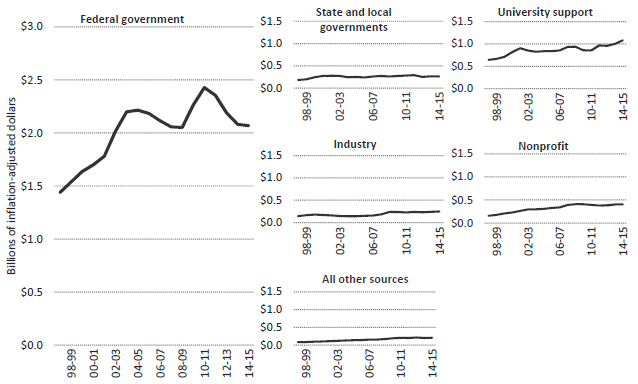
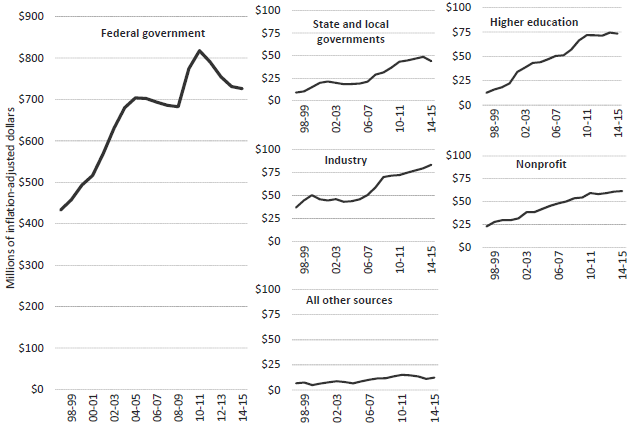
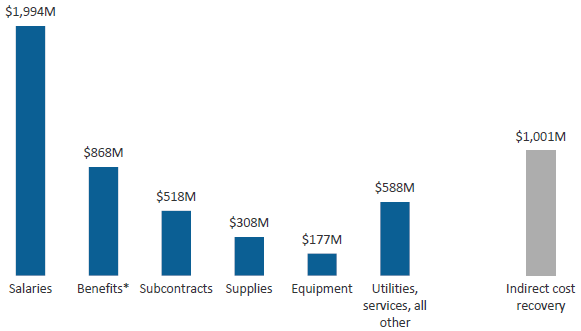
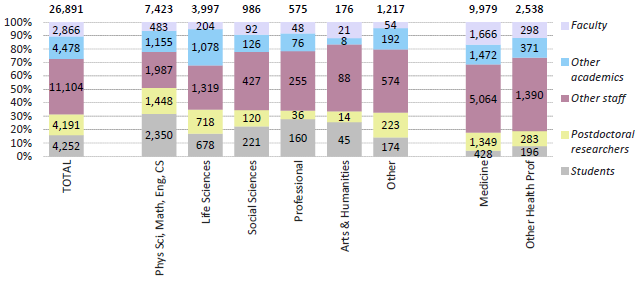

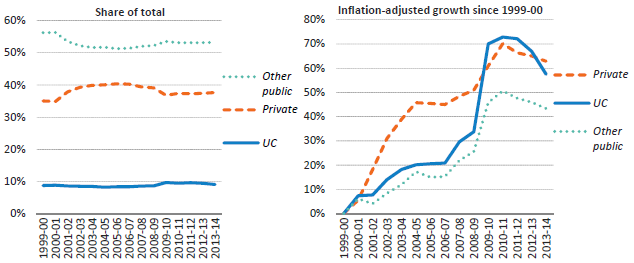

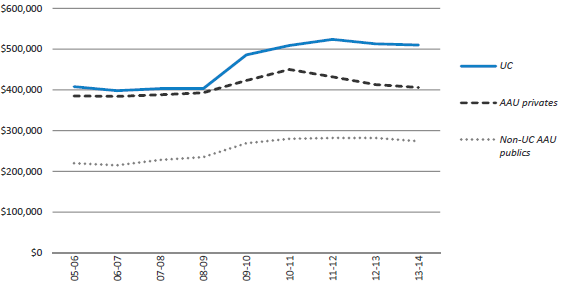



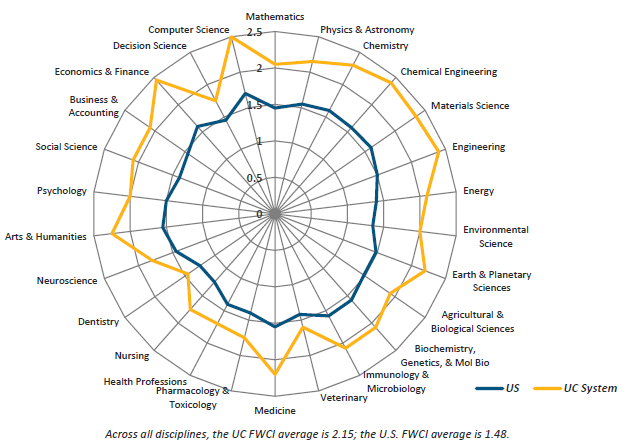


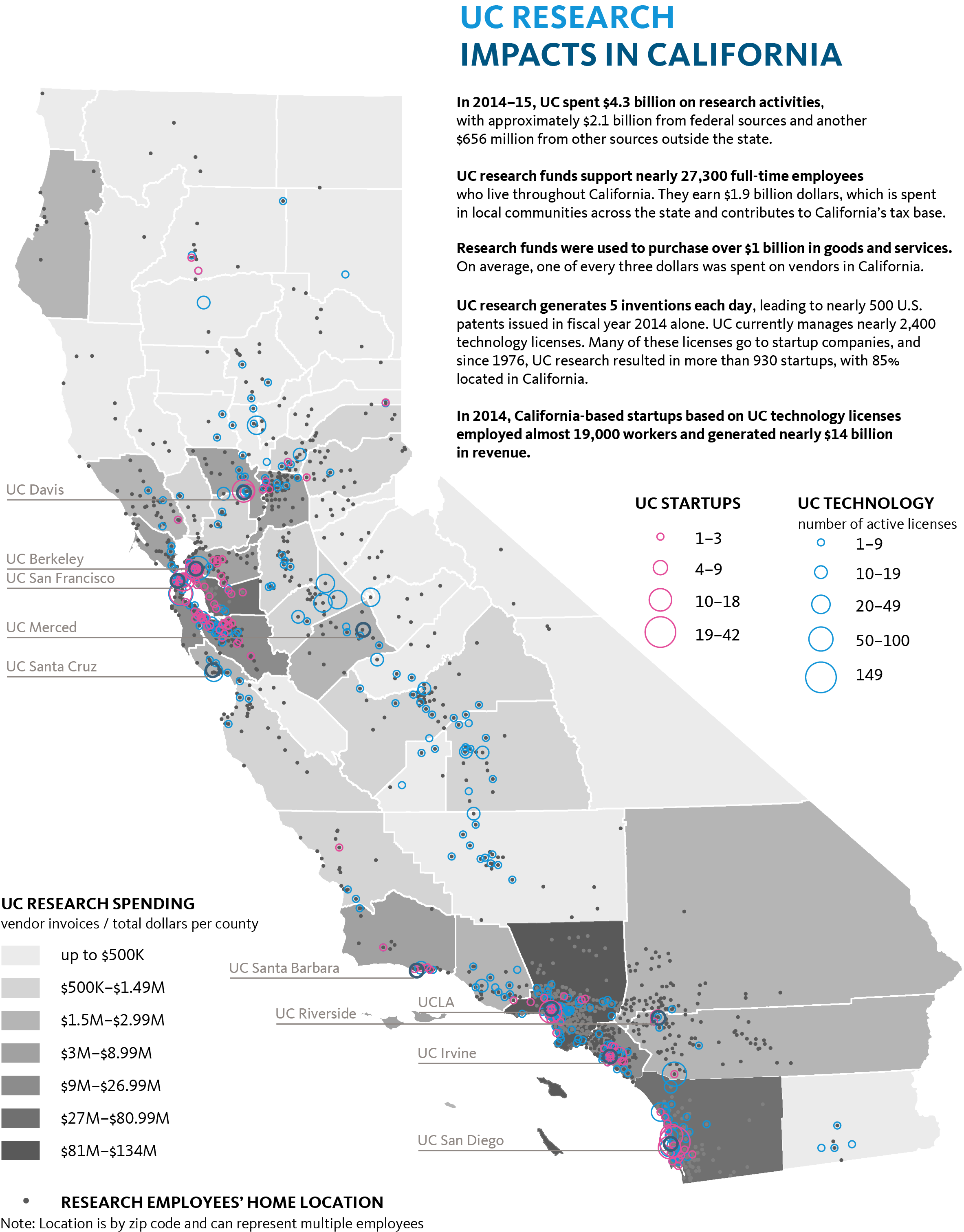


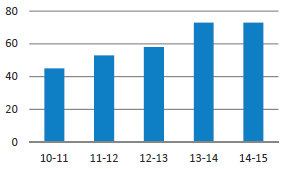
 Source: UC Contracts & Grants System
Source: UC Contracts & Grants System